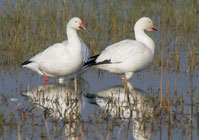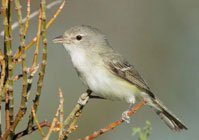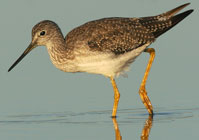Accomplishments
The CVJV partnership has earned an impressive record of accomplishment since its inception in 1988, and is making great progress towards meeting the objectives identified in its 2020 Implementation Plan.

 Bell’s Vireo
Bell’s VireoBy Dale Garrison
CVPIA Refuge Water Supply Coordinator, USFWS

As everyone is painfully aware, California is in the grips of a serious drought, which is continuing to have a major impact upon wildlife habitat throughout the state. The examples are numerous – staff at Lower Klamath National Wildlife Refuge project being able to maintain just 33% of their typical fall seasonal wetland acreage this year; 33,000 acre-feet of Incremental Level 4 water acquired this year for the 19 state, federal and private refuges (refuges) that come under the auspices of the Central Valley Project Improvement Act of 1992 (CVPIA), was the worst since the mid-1990’s. Despite the dry conditions California is experiencing in 2013 and the uncertain hydrologic outlook for 2014, there is at least some comforting news: The refuges that come under the auspices of the CVPIA are assured of receiving both their full Level 2 water supplies, as well as the amount of Incremental Level 4 supply that each refuge staff currently has scheduled to use through the end of the current Water Year 2013 (which ends February 28, 2014). However, if conditions remain dry, it is quite possible that Water Year 2014 will be operated under water shortage criteria, whereby all CVPIA refuges will be reduced to 75% of their full Level 2 amounts.
There are several options currently being considered for dealing with these ongoing dry conditions. One suggestion being discussed involves retaining some water in Shasta and Folsom reservoirs longer than usual this fall, in order to ensure a cool water supply for fishery flows, and reduce the threat of spawning bed de-watering. If implemented, this idea could result in a delay, reduction or elimination of water typically used to post-harvest flood tens of thousands of acres of rice fields in the Sacramento Valley. These ricelands, together with state wildlife areas, federal refuges and private duck clubs, provide critical fall and wintering habitat for migratory birds utilizing the Pacific Flyway. The Bureau of Reclamation (BOR) is currently working with all CVPIA refuge managers to determine what habitat and wildlife impacts could occur if such changes were implemented this coming fall – to refuge lands, to private lands under Service conservation easement, and to the rice ground itself.
Meanwhile, the quest for more secure, long-term refuge water supplies continues. Over the past eight months the BOR has facilitated a process to develop strategies to both meet CVPIA obligations for all 19 CVPIA refuges, and also secure new water supplies for south-of-Delta service contractors. Additionally, Technical and Policy Teams were organized in late 2012, and regularly meet to assess, refine and implement the strategies that are developed.
The CVJV partnership has earned an impressive record of accomplishment since its inception in 1988, and is making great progress towards meeting the objectives identified in its 2020 Implementation Plan.

Follow these links to learn about some of the important bird conservation work happening in California's Central Valley.
